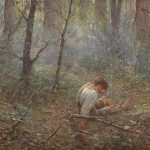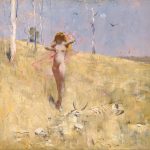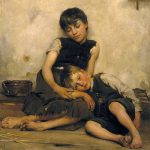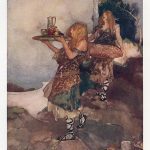Russell Drysdale, born on February 7, 1912, in Bognor Regis, Sussex, England, and later becoming one of Australia’s most celebrated artists, was a prominent figure in 20th-century Australian art. Renowned for his distinctive approach to depicting the Australian outback and its inhabitants, Drysdale’s works captured the vastness, isolation, and social complexities of the Australian landscape.
In 1923, Drysdale and his family moved to Melbourne, Australia, where his exposure to the unique Australian environment began to influence his artistic sensibilities. He studied at the National Gallery School in Melbourne and later at the Grosvenor School of Modern Art in London.
Drysdale’s early works were marked by a fascination with the Australian landscape and its people. His paintings from the 1930s, such as “Drovers Wife” (1945), depicted the harshness of rural life and the resilience of those living in the outback. Drysdale’s choice of subject matter reflected his keen observation of the social and cultural aspects of Australian society.
The artist’s distinctive style, often characterized by elongated and distorted figures, contributed to the surreal and dreamlike quality of his paintings. Drysdale’s use of color and composition conveyed the emotional and psychological impact of the vast Australian landscape on its inhabitants.
During the 1940s and 1950s, Drysdale’s art gained prominence both in Australia and internationally. His paintings were featured in major exhibitions, and he received critical acclaim for his unique vision of the Australian outback. Notable works from this period include “The Cricketers” (1948) and “West Wyalong” (1949).
Drysdale’s exploration of the Australian interior extended beyond traditional landscape painting. He often focused on the marginalized and dispossessed individuals, including Indigenous Australians and settlers facing the challenges of life in the outback. This empathetic approach to his subjects set Drysdale apart as a socially conscious artist.
In addition to his paintings, Drysdale produced illustrations for books and collaborated with notable Australian writers. His deep connection to literature and storytelling influenced his visual narratives, adding layers of meaning to his works.
Russell Drysdale received numerous awards and honors for his contributions to Australian art, including the Order of the British Empire (OBE) in 1957. Despite facing health challenges in his later years, he continued to paint and exhibit his work.
Russell Drysdale passed away on June 29, 1981, leaving behind a legacy that reshaped the narrative of Australian art. His ability to capture the essence of the Australian outback and its people, combined with his social awareness and distinctive artistic style, cemented his place as one of Australia’s preeminent artists of the 20th century.





